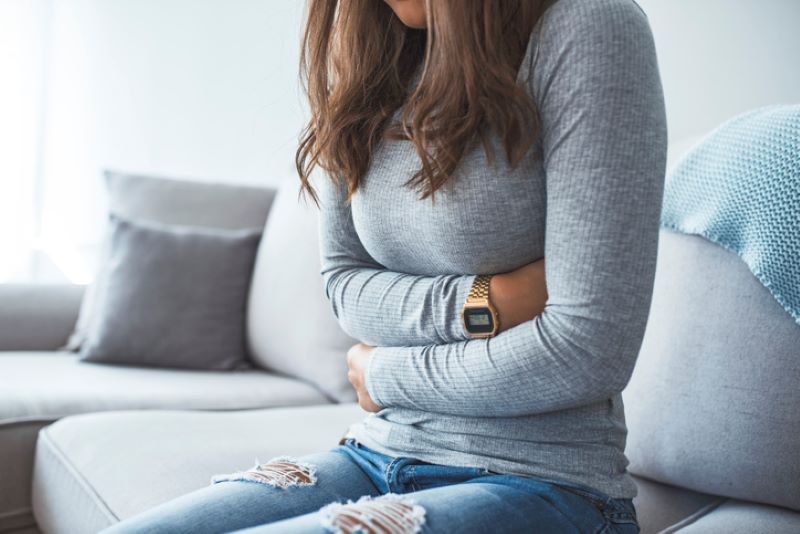
Many women may have experienced heavy bleeding, intense and painful cramping, or uncomfortable bloating while on their period. But did you know that this may not always be a fluke? If these symptoms are present during every menstrual cycle, you may be experiencing something called adenomyosis.
Adenomyosis is a condition in which the endometrial tissue, which should normally only be lining your uterus, grows inside the muscle walls of the uterus. When this happens, the endometrial tissue continues to act as normal, thickening and shedding like a normal period.
Adenomyosis has been primarily diagnosed in pre-menopausal women (40s-50s), however, 2-5% (and climbing) of adolescents with severely painful menstrual cycles may have adenomyosis as well. Understanding of this condition is constantly improving, with experts in the field noticing more and more young people getting proper care for adenomyosis.
While there is no official cause for adenomyosis, it is believed that if you’ve had a uterine surgery, like a cesarean delivery (C-section), accidental incisions in the uterine muscle may create gaps where endometrial tissue can form inside the muscular wall of the uterus, creating adenomyosis. Otherwise, inflammation following childbirth may cause a break in the uterine muscles.
Other theories involve genetic or cell-related origins. These link adenomyosis to traits that are formed while a fetus is developing, which later present after years of menstruation.
Symptoms of Adenomyosis
The intense cramps that women with adenomyosis often feel are likely due to the excess of a substance called prostaglandin. Prostaglandins help control contractions (cramps) during a period. Those with adenomyosis may have higher levels of prostaglandins because of inflammation in the uterus.
Heavy bleeding that tends to befriend adenomyosis may be due to a larger amount of endometrial tissue, an increase in blood flow, abnormal cramps, and higher levels of hormones (prostaglandins, estrogen, etc.). Basically, when the endometrial tissue grows in the muscle walls of the uterus, it creates more material for the body to shed during a period.
Uncomfortable and abnormal bloating may be experienced because the uterus is swelling. This is normal for adenomyosis due to the extra tissue in the walls of the uterus. Pelvic pain and pain during sexual activity (dyspareunia) may also be symptoms of adenomyosis.
Those with adenomyosis may experience fertility issues, because there is less available endometrial tissue for an embryo (the result of sperm fertilizing an egg) to attach itself to. This may also be due to inflammation and extras of certain hormones that can change the ability of the uterus to support an embryo or fetus.
Likely Treatments
Providers may recommend anti-inflammatory medications like ibuprofen or Midol for pain relief. Any prescriptions may include hormonal options like birth control or intrauterine devices (IUDs), or non-hormonal medications like tranexamic acid. There are other non-medication treatment options available that may affect fertility, so these medication options may be the first line of defense for providers.
If adenomyosis continues to be painful and unmanageable with medications, less invasive techniques may be recommended. Procedures like thermal ablation may be suggested. Thermal ablation is a minimally invasive treatment that uses heat to destroy abnormal endometrial tissue that has infiltrated the uterine muscle wall (myometrium). The goal is to reduce symptoms like heavy menstrual bleeding, pelvic pain, and cramping by targeting and shrinking the adenomyotic lesions.
Providers may also suggest a surgical option called “adenomyomectomy,” in which localized areas of the adenomyosis are removed from the uterine muscles. This is another uterine-sparing option that preserves fertility because it leaves the endometrial tissue and uterine walls relatively intact.
At the moment, the most definitive “cure” for adenomyosis continues to be a hysterectomy, which completely removes the uterus. Care for adenomyosis may revolve around other options before hysterectomy is recommended, especially in younger individuals who desire to preserve fertility.
Key Points
- Adenomyosis is a condition that can negatively impact sexual well-being and overall quality of life in people who menstruate.
- Those who are over the age of 30, have given birth before, have endometriosis, or who have had a uterine surgery performed are more at-risk for developing adenomyosis.
- The most common treatment for adenomyosis continues to be anti-inflammatory or hormonal medications.
- Research around adenomyosis is constantly in motion, with treatments evolving as well.
- If you have abnormal, heavy periods with intensely painful cramps, it may be beneficial to speak with a healthcare provider.
References:
Dessouky, R., Gamil, S. A., Nada, M. G., Mousa, R., & Libda, Y. (2019). Management of uterine adenomyosis: Current trends and uterine artery embolization as a potential alternative to hysterectomy. Insights into Imaging, 10(1). https://doi.org/10.1186/s13244-019-0732-8
Gunther, R. (2023, June 12). Adenomyosis. StatPearls [Internet]. https://www.ncbi.nlm.nih.gov/books/NBK539868/
Santulli, P., Vannuccini, S., Bourdon, M., Chapron, C., & Petraglia, F. (2025). Adenomyosis: The missed disease. Reproductive BioMedicine Online, 50(4), 104837. https://doi.org/10.1016/j.rbmo.2025.104837
You may also be interested in...
Other Popular Articles

What Is the Average Penis Size?
If you have ever wondered how your penis compares to others in terms of size, you are not alone. Many men are curious to know how their penises stack up compared to the average. Unfortunately, general curiosity can sometimes give way to full-on obsession and anxiety about penis size. This can be an unhealthy and often unnecessary fixation, especially because most men who think their penises are too small have perfectly normal-sized penises.

What Is Jelqing, and Does It Actually Work?
The term “jelqing” refers to a set of penis stretching exercises that some believe can make the penis bigger. Although the practice has gained attention and popularity in blogs and internet forums in recent years, there is no scientific evidence that it is an effective way to permanently increase the size of one’s penis. In fact, in some cases, jelqing may actually cause damage to the penis, so it is a good idea to get all the facts before setting off to try it.

What Is Sensate Focus and How Does It Work?
Sensate focus is a technique used to improve intimacy and communication between partners around sex, reduce sexual performance anxiety, and shift away from ingrained, goal-oriented sexual patterns that may not be serving a couple.

Can Sex Reduce Menstrual Cramps?
The SMSNA periodically receives and publishes ‘guest editorials.’ The current article was submitted by Mia Barnes, a freelance writer and researcher who specializes in women's health, wellness, and healthy living. She is the Founder and Editor-in-Chief of Body+Mind Magazine.
Having sex while you experience menstrual cramps is healthy and can provide significant benefits. While it might not be the first activity that comes to mind when your PMS or period cramping begins, many people enjoy sex to reduce menstrual cramps, experience increased pleasure and benefit from other advantages. Learn more about having sex while menstrual cramps are happening and how it can help your body.

How Long Does It Take the Average Man to Ejaculate?
On average, it takes a man between 5 to 7 minutes to orgasm and ejaculate during sexual intercourse.

The Effect of Regular Aerobic Exercise on Erectile Function
Erectile dysfunction (ED) is the inability to achieve or maintain an erection sufficient for satisfactory sexual activity. As men get older, their erectile functioning may naturally decline due to changes in testosterone levels, cardiovascular functioning, and the potential development of other chronic medical conditions that become more common with age.
You are prohibited from using or uploading content you accessed through this website into external applications, bots, software, or websites, including those using artificial intelligence technologies and infrastructure, including deep learning, machine learning and large language models and generative AI.

